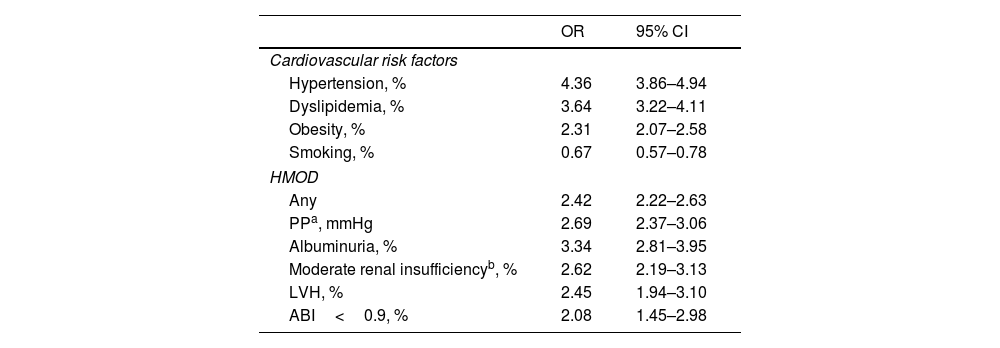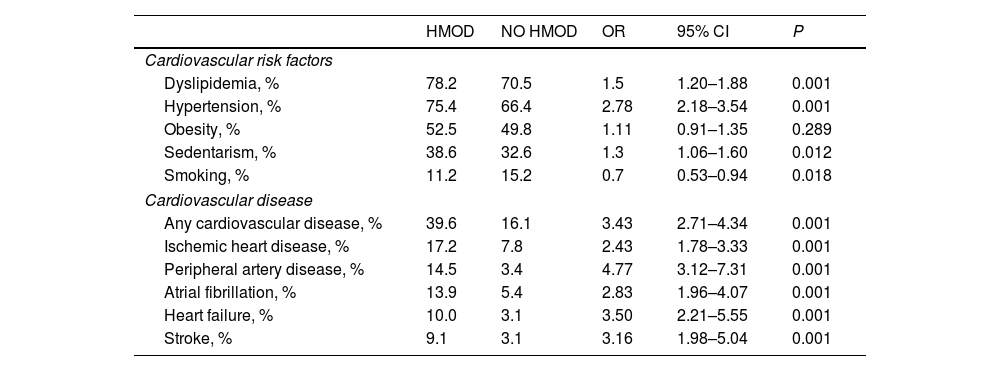To determine the prevalence, impact and management of hypertension-mediated organ damage (HMOD) according to the presence of type 2 diabetes (T2DM).
MethodsIBERICAN is an ongoing multicenter, observational and prospective study, including outpatients aged 18–85 years who attended the Primary Care setting in Spain. In this study, the prevalence, impact and management of HMOD according to the presence of T2DM at baseline were analyzed.
ResultsAt baseline, 8066 patients (20.2% T2DM, 28.6% HMOD) were analyzed. Among patients with T2DM, 31.7% had hypertension, 29.8% dyslipidemia and 29.4% obesity and 49.3% had ≥1 HMOD, mainly high pulse pressure (29.6%), albuminuria (16.2%) and moderate renal impairment (13.6%). The presence of T2DM significantly increased the risk of having CV risk factors and HMOD. Among T2DM population, patients with HMOD had more dyslipidemia (78.2% vs 70.5%; P=0.001), hypertension (75.4% vs 66.4%; P=0.001), any CV disease (39.6% vs 16.1%; P=0.001) and received more drugs. Despite the majority of types of glucose-lowering agents were more frequently taken by those patients with HMOD, compared to the total T2DM population, the use of SGLT2 inhibitors and GLP-1 receptor agonists was marginal.
ConclusionsIn patients daily attended in primary care setting in Spain, one in five patients had T2DM and nearly half of these patients had HMOD. In patients with T2DM, the presence of HMOD was associated with a higher risk of CV risk factors and CV disease. Despite the very high CV risk, the use of glucose-lowering agents with proven CV benefit was markedly low.
Determinar la prevalencia, impacto y manejo del daño orgánico mediado por hipertensión (HMOD) según la presencia de diabetes tipo 2 (DM2).
MétodosIBERICAN es un estudio multicéntrico, observacional y prospectivo, que incluye pacientes entre 18 y 85 años que acuden a consultas de atención primaria en España. En este estudio se analizó la prevalencia, el impacto y el manejo de la HMOD según la presencia de DM2 al inicio del estudio.
ResultadosSe analizaron 8,066 pacientes (20,2% DM2, 28,6% HMOD). Entre los pacientes con DM2, el 31.7% tenía hipertensión, el 29,8% dislipidemia, el 29,4% obesidad y el 49,3% tenía≥1 HMOD, principalmente presión de pulso elevada (29,6%), albuminuria (16,2%) e insuficiencia renal moderada (13,6%). La presencia de DM2 aumentó significativamente el riesgo de tener factores de riesgo cardiovasculares y HMOD. Entre la población con DM2, los pacientes con HMOD tenían más dislipidemia (78,2% frente a 70,5%; p=0,001), hipertensión (75,4% frente a 66,4%; p=0,001), cualquier enfermedad cardiovascular (39,6% frente a 16,1%; p=0,001) y recibieron más fármacos. A pesar de que los pacientes con HMOD tomaban con mayor frecuencia la mayoría de los tipos de agentes hipoglucemiantes, en comparación con la población total de DM2, el uso de inhibidores de SGLT2 y agonistas del receptor de GLP-1 fue marginal.
ConclusionesEn los pacientes atendidos diariamente en atención primaria en España, uno de cada 5 pacientes tenía DM2 y casi la mitad de estos pacientes tenían HMOD. En pacientes con DM2, la presencia de HMOD se asoció con un mayor riesgo de factores de riesgo cardiovasculares y enfermedad cardiovascular. A pesar del riesgo cardiovascular muy alto, el uso de agentes hipoglucemiantes con beneficio cardiovascular demostrado fue notablemente bajo.
Artículo
Diríjase al área privada de socios de la web de la SEMERGEN, (https://www.semergen.es/index.php?seccion=biblioteca&subSeccion=revistaSEMERGEN ) y autentifíquese.
Comprando el artículo el PDF del mismo podrá ser descargado
Precio 19,34 €
Comprar ahora













